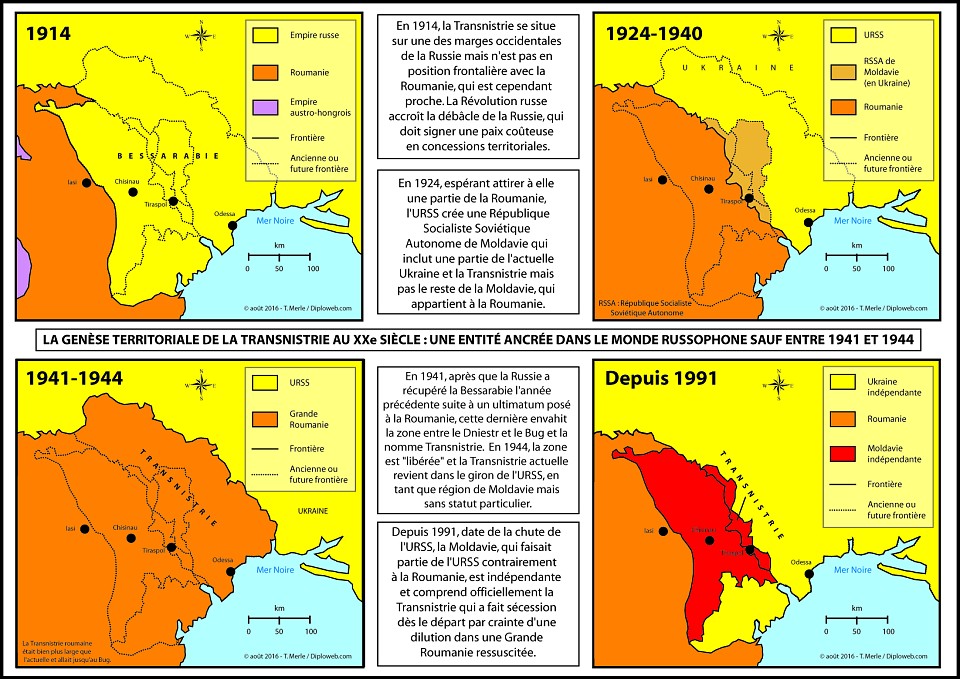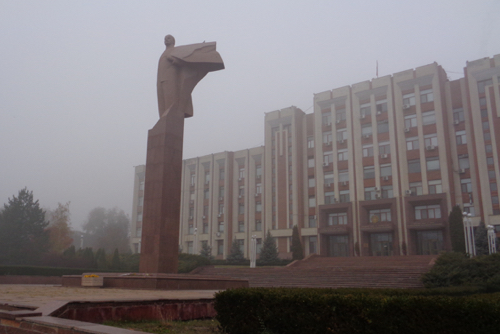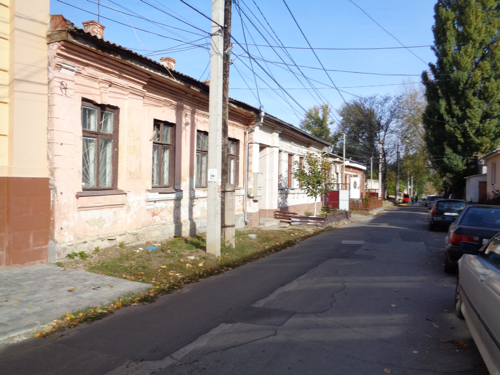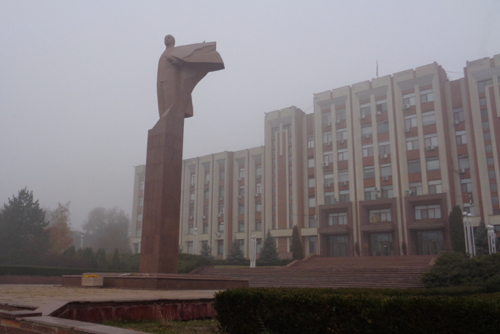By , March 5, 2024
Catherine Durandin, University Professor, historian, former student of the ENS, former auditor of the IHEDN. Former consultant at the DAS, Ministry of Defense, C. Durandin has published a large number of articles and works devoted to Romania and the geopolitical balances of the contemporary world.
Russia is able to use Transnistria as a regional weapon. For what ? Catherine Durandin provides the keys by shedding light over a long period of time on the history of a Moldovan region, Transnistria, established as a beacon of the USSR since 1924. She clearly explains how this “frozen” question could be reactivated by Russia in the framework of its war in Ukraine, and against NATO of which neighboring Romania has been a member since 2004. With two photos and a map.
A future INTEGRATION of Transnistria into the Russian Federation? The scenario emerged on the eve of Vladimir Putin’s speech to the Nation on February 29, 2024.
A first warning signal is sounded: the President of the Moldovan Republic of Transnistria, Vadim Krasnosselski, elected in 2016 and re-elected in 2021, announces that the Congress of Transnistrian Deputies intends, during its meeting on February 28, 2024, to request or organize a referendum on the annexation of Transnistria to Russia . He puts forward the need to protect Russian citizens and “compatriots” of Transnistria from threats from the Republic of Moldova and NATO. Including: on February 28, 2024, the Transnistrian Parliament asked the Russian Duma for “measures to defend Transnistria given that more than 220,000 Russian citizens reside in Transnistria. » The Republic of Moldova imposed new customs duties on imports and exports from Transnistria in January 2024. But, no information has circulated regarding citizens of Transnistria being molested by nationals of Moldova…
Already in September 2006, the population of Transnistria was consulted on the question of independence and integration into the Russian Federation, responding positively to more than 96% of the votes. In 2014, this project was brought up again. Moscow thus retained a sword of Damocles over Ukraine and Moldova. However, the Russian attack, launched on February 24, 2022 against Ukraine, seriously weakens the security of the Republic of Moldova. Odessa, the port of Russian dreams of grandeur, is only 193 km from Chisinau, capital of Moldova and 139 km from Tiraspol, capital of Transnistria . Moldova and Ukraine stand together, tens of thousands of Ukrainians have emigrated to Moldova.
Moscow is able to use Transnistria as a regional weapon.

To understand how, we must rediscover the long-term past of a Moldavian region, Transnistria, established as a beacon of the USSR since 1924, on the then border of Bessarabia integrated into Greater Romania in 1918/1920. The history of Transnistria is linked to the USSR, Soviet Moldova, and then Russia. Transnistria seceded from Moldova, proclaiming its independence in 1991, an independence that is not recognized by either Russia or Moldova. Transnistria maintains diplomatic relations with South Ossetia, Abkhazia and Nagorno-Karabakh .
In 2024, Transnistria will have nearly 500,000 inhabitants, covering an area of 4,000 km2; Russian speakers are in the majority there alongside Moldovans, Ukrainians, and a few Polish and Bulgarian minorities. The population is Russian-speaking, often bilingual, Russian/Moldavian and Russian/Ukrainian. Transnistria recognizes three official languages: Russian, Ukrainian and Moldovan. In fact, Russian is the language spoken everywhere. Transnistria is a country that is more than 90% Orthodox, just like neighboring Moldova .
What does this initiative to propose a referendum on integration with Russia mean in February 2024? What would be the possible consequences?
Such a population consultation project initiative is part of the current context of the Russo-Ukrainian war and Russian expansion policy, associated with a desire to destabilize the eastern European markets of the European Union. The project threatens, first of all, the Republic of Moldova, recently a candidate for the EU.
For Moscow, annexing Transnistria would meet two objectives: establishing a military bridgehead targeting Ukraine from its western flank, breaking the Republic of Moldova. Neutrality is enshrined in the Moldovan Constitution but its candidacy for integration into the European Union was accepted in June 2022 and the process is underway.
The divide between the history of the Republic of Moldova and that of Transnistria goes back to the times of the rupture, the war and the hostilities between Romania, an ally of the Entente between 1916 and 1918, against the Russians on a revolutionary march in 1917/1918. Under the domination of the Russian Empire to which Bessarabia has been attached since 1812, the province has shared the Russian revolutionary upheavals since 1905 and vibrated to the rhythm of national emancipations within this bankrupt empire. Moldovan intellectuals, at the head of nationalist and social movements close to the socialist intelligentsia of Odessa, then moved from the demand for autonomy to that of independence during the months of 1917/1918. The violence of the Bolsheviks, of the soldiers’ soviets in particular, of the revolutionaries of Odessa, pushed the democrats, liberals and conservatives of Bessarabia to appeal to the Romanian army to restore order in January 1918 and to vote hastened integration into Greater Romania, emerging from the victory of the Entente.
The Soviets never accepted this loss of Bessarabia . During the interwar period, a phase of Romanian history in Bessarabia, Moscow sought to destabilize the province: Soviet agents, incursions from across the Dniester, peasant uprising organized in Tatar Bunar, a large town in Romanian Bessarabia, repressed very violently by Bucharest.
Moscow took a radical initiative by creating on the border with Romania on the right bank of the Dniester, a model Soviet republic, anti-Romanian, with a new city Tiraspol, the Soviet capital of reference. Tiraspol is designed as a new industrial city while Bessarabia remains essentially rural and poorly developed. In 1924, the Autonomous Moldovan Soviet Socialist Republic (RASSM) was born. From a strategic point of view, the objective is clear: to put pressure on Romania, on its western border.
Throughout the history of the empire and then the USSR, the Russians have never accepted the loss of Bessarabia. They negotiated its recovery, in June 1940, with Nazi Germany, during the Ribbentrop-Molotov Pact agreement . Strengthened by this Pact, they demanded, on June 16, 1940, from the Romanian government the evacuation within 24 hours of the territory of Bessarabia and Northern Bukovina. Soviet forces occupied Bessarabia on June 28, 1940 and created the Moldovan Soviet Socialist Republic (RSSM) which included Transnistria.
This Soviet history lasted until the breakup of the USSR in 1990/1991 with a brief presence of Romanian occupation from 1941 to 1944. Transnistria never experienced democratic breathing. Indeed, in 1941, it is found in the path of the Romanian armies allied with Hitler and Nazi Germany under the government of Marshal Antonescu. The Romanians occupied Transnistria: they made it a deportation zone for Jews from Romania brought by trains and carried out the virtual liquidation of the Jewish population of Odessa. Victorious here in 1944, the USSR reestablished the Moldavian Soviet Socialist Republic…
It was only with the complex process of the end of the Soviet empire , the libertarian and identity demands of its republics, the aspirations concerning the use of the national language, Romanian, that on June 23, 1990, the Soviet Supreme Moldova adopts the declaration of sovereignty and the tricolor flag. The border opens between ex-Soviet Moldova and post-Ceausescu Romania, with more than 100,000 Romanians and Moldovans fraternizing.
Transnistria is not Romanian. The pro-Romanian romantic unionist impulses of Moldova weigh like a threat on Transnistria which refuses any union with Romania! The war, a virtual civil war, a fratricidal war, broke out in 1992 between Moldovans and Transnistrians who were supported by elements of the XIVth army resulting from the late Warsaw Pact [ 1 ] . With on the Russian side, the command of General Lebed, veterans of Afghanistan, Cossacks. We fight near the Dniester, in Bender, whose houses retain bullet marks on their facades. The fighting left more than a thousand dead and hundreds injured, leading to a ceasefire agreement on July 21, 1992, signed by Moldovan President Mircea Snegur and the President of the Russian Federation, Boris Yeltsin. . Russia and the OSCE are mediators in the ceasefire process.
These months of war in 1992 have not been forgotten. Many works have been published in Moldova on this confrontation. Also in 2013, the second edition of the widely read work by journalist Valentina Ursu, “The River of Blood” was published (Editions Arc, Chisinau).
Since the cessation of hostilities in 1992, plans to resolve the Transnistria issue have followed without success despite hope on the Russian side in 2003. All involved a federalization project. In vain, the Russians , the United States and the OSCE got involved. An independent Transnistria? A federation with demilitarization of the Republic of Moldova? This solution is refused by Moldova. But hostilities did not resume.
The Russian forces, few in number, 1,500 men, are still present near the Dniester, with arms depots still present at Cobasna in Transnistria, not far from the Ukrainian border. The armed forces of Transnistria are philo-Russian, a number of conscripts do their military service in Russia. The economy of this former Soviet Moldova, highly industrialized during the USSR, functions well, with a powerful metallurgy and a developed textile industry. But the profitable traffic in arms, alcohol and cigarettes between Tiraspol and Odessa has been seriously disrupted by the war in Ukraine. Ukraine controls its border.
Moldova is moving, with difficult steps, towards the EU under the presidency of Maia Sandu, elected in December 2020, at the head of a pro-European government . The municipal elections in fall 2023 saw the weakening of Maïa Sandu’s PAS (Action and Solidarity) party. Emigration, a real hemorrhage since independence, weakens this country of 2,600,000 inhabitants, tired of poverty and the great corruption which has deeply penetrated the judicial field . However, a new generation is emerging, attached as a priority to the study and treatment of socio-economic problems, refusing to be locked into the EU or Russia dilemma, considering that the obsession with identity is an alibi for not focusing on economic emergencies. To the West as to the East of the Dniester, the extremely wealthy mafiosi, those we call “the barons”, interfere in the political game. The government in Chisinau is fighting against this presence. Pursued by the courts, several great “barons”, Ilian Shor, Vladimir Plahotniuc, chose to retreat abroad.
In Tiraspol, on the other hand, the Sheriff group, founded in the early 1990s, is quietly thriving, enjoying unparalleled economic power that ranges from supermarkets to gas stations, to the ownership of a television channel, not to mention the control over the national football club, marked by the construction of a sports complex in 2000 costing more than 100 million dollars. The son of Igor Smirnov, the first pro-Soviet president of Transnistria, is one of the leading members of the Sheriff group…

In Tiraspol, the single party reigns supreme, citizens and visitors are greeted by a colossal statue of Lenin flanked by a rusty tank, close to a vast administrative building in Soviet architectural style, while political science students from the university at which I was forbidden to speak Romanian in 2009, are able to express themselves in English. In 2009, they were interested in the fate of Ségolène Royal following the failure of her candidacy for the presidency of the French Republic! Students get information via the internet!
SO ? The landscape is faithfully, proudly Soviet.
Mentalities ? Rather pragmatic, in times of peace. Movement is easy between the two capitals, Tiraspol and Chisinau, some Moldovans have family in Tiraspol, citizens of Transnistria frequent Chisinau.
Russia is powerful, the Republic of Moldova is not. May Transnistria become a future reinforced Russian base? This development is probable. It is in Moscow’s interest to develop pro – Russian networks on the border of Ukraine and Moldova.
Transnistria is not pro-Romanian, never has been, has no democratic experience . It’s an ex-Soviet gem, how corrupted from the inside? The economy of Transnistria has evolved: 70% of exports are to the EU, Ukraine and Moldova. But, for populations attached to peace, a peace preserved since 1992, NATO represents a threat of war perfectly instilled in mentalities by Russian propaganda… However, Ukraine is supported by NATO allies, Romania is a member of NATO, with 6 American bases, 2 French bases, one of which is on the edge of the Black Sea. The obsession with security has spread to the Republic of Moldova, which on September 25, 2023 signed a defense agreement with France and negotiated the acquisition of a Thales air protection radar, during the visit to Chisinau of the Minister of the Armed Forces. Sébastien Lecornu.

Will Russia be in a hurry to opt for the annexation of Transnistria? Will Putin wait until the next presidential elections in 2024 in the Republic of Moldova to bring down the pro-European party and eliminate Maia Sandu at the ballot box? Let us imagine a Republic of Moldova, disappointed by the constraints and slowness of the European integration process, under the influence of Russian propaganda, tempted by a rapprochement with Russia. Let’s imagine the worst-case scenario for Moldovan democracy: a Transnistria/Republic of Moldova federation that could join forces with the Russian Federation.
President Vadim Krasnosselski’s initiative opened Pandora’s box. The current configuration, Republic of Moldova under pro-European but divided governance and Transnistria pragmatically quiet but landlocked, could collapse. Tiraspol calls for help against alleged embezzlement by Chisinau, will Putin remain indifferent to this appeal? What will be the modalities of Russian action , beyond the declaration of the Russian Ministry of Foreign Affairs in immediate response to the appeal of February 28, 2024 launched by the President of Transnistria: “Protecting the interests of the inhabitants of Transnistria, our compatriots, is one of the priorities. »
Copyright March 5, 2024-Durandin/Diploweb.com




